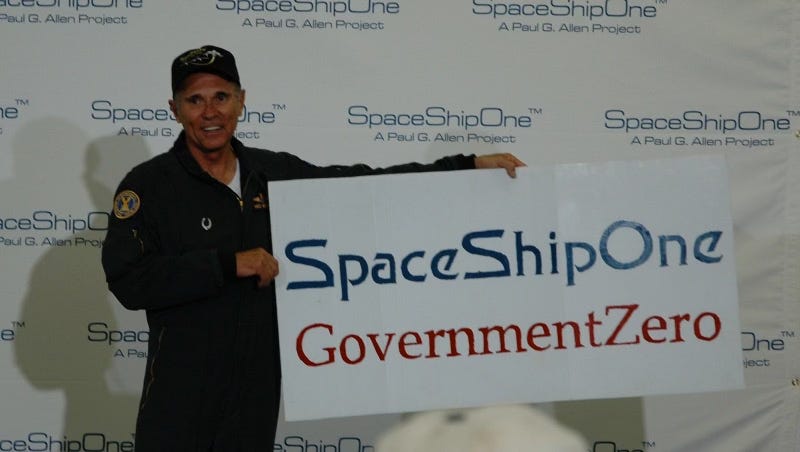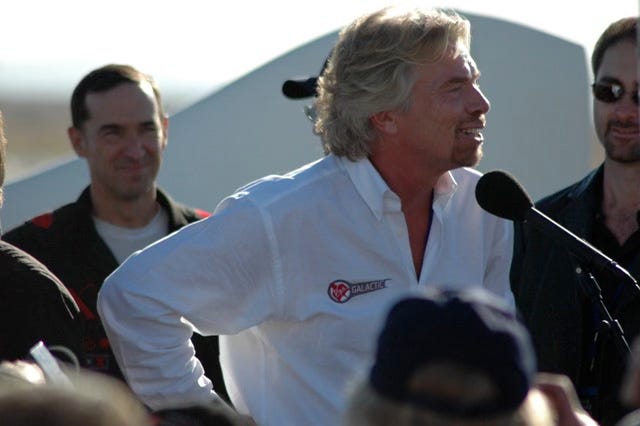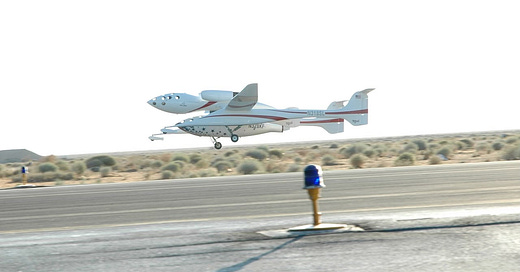Wacky Space Cowboy Launches Commercial Space: SpaceShipOne 20 Years Ago Today
Chapter 3: Red Moon Rising Serialization
Over the next few months, I will be sharing insights from my new book, with Peter Navarro, Red Moon Rising: How America Will Beat China on the Final Frontier on this Substack. Today, I’m offering you a few sneak peeks into chapter 3, which details the surprising history of commercial spaceflight. You can find the full book on Amazon or if you subscribe I’ll release full chapters here. Enjoy!
Meanwhile, back in the High Desert of California, legendary aircraft designer Burt Rutan was working on his next quixotic project. Rutan had revolutionized the low-end general aviation market with a line of composite aircraft kits that folks could assemble at home. He had been a civilian test pilot at Edwards Air Force Base during the ’60s and had seen the X-15 in action. His firm, Scaled Composites, would build a less expensive, civilian version of that spaceplane to win a prize dreamed up by another wild-eyed space activist. Peter Diamandis had always wanted to go to space and strategically prepared his career to be the ideal astronaut candidate. He obtained a master’s in aeronautics and astronautics from MIT and an MD from Harvard. However, working with astronauts on projects at NASA’s Johnson Space Center disillusioned him. During the shuttle era, things just moved too slowly. He told Wired, “I’m sick and tired of waiting.”
Looking at the events that had broken open aviation in the last century, Diamandis had discovered that Lindbergh and many others had made their risky record-setting flights in the pursuit of prize money. In one notable case, pineapple magnate James D. Dole, who desired quicker transportation from California to Hawaii, put up a $25,000 prize for the first air flight from Oakland to Honolulu. Two aircraft completed the 1927 Dole Air Race, six were lost or crashed, and ten people perished. Diamandis decided to offer a $10 million prize for the first successful, reusable suborbital spacecraft. He announced his X-Prize at the National Space Society’s International Space Development Conference in 1995. The biggest problem was that he didn’t have $10 million. Diamandis convinced Anousheh Ansari and her family to pay the premiums for a Lloyd’s of London “hole in one” insurance policy that would pay $10 million in the event of a private firm completing spaceflights by 2005.
Rutan had the good fortune to find billionaire Microsoft cofounder Paul Allen. Allen, another space crazy entrepreneur, had previously rescued the Search for Extraterrestrial Intelligence (SETI) when Congress stopped funding the radio telescope program made famous by Jodie Foster in the film Contact.303 Allen eventually put $24 million into Rutan’s project, and by early 2004, Rutan had a revolutionary vehicle ready to go. Like the X-15, this system included a large carrier plane, White Knight, and a smaller rocket-powered spacecraft named SpaceShipOne. The spacecraft would be powered by hybrid motors from SpaceDev, technology inherited from the Dolphin project.

Rutan, like many disruptive entrepreneurs in the commercial space era, was an ardent libertarian who bristled at governmental bureaucracy. He dressed in the jeans, boots, and big belt buckles that signaled the independent attitude of High Desert “cowboy aviation.” However, Rutan found his firm was able to establish a good relationship with the FederalAviation Administration’s Office of Commercial Space Transportation (FAA/AST). Upon accepting the FAA’s license from Associate Administrator Patti Grace Smith, he turned to the audience and said, “Never let it be said that I don’t kiss up to the government.”304 Stuart O. Witt, the CEO and general manager of the Mojave Airport, was instrumental in the success of the project and in getting Mojave licensed to conduct suborbital spaceflights as the nation’s first inland spaceport.

On the morning of June 21, 2004, SpaceShipOne was dropped from White Knight, and pilot/astronaut Mike Melville flew the little craft through the US fifty-mile limit and above the 100-km Kármán line at a top speed just shy of Mach. NASA’s human spaceflight program was in the middle of a three-year hiatus induced by the Columbia disaster, and so Melville proudly posed with a large placard reading “Space-ShipOne, Government Zero.” In September and October of that year, Melville and Brian Binnie would make two flights within a week and capture the X-Prize. SpaceShipOne is now on display at the National Air and Space Museum in Washington, DC.

For commercial space dreamers, the real win in the event came with Sir Richard Branson stepping up to a microphone and announcing the formation of a new company, Virgin Galactic, with his intent to purchase spacecraft built by Rutan in order to commercialize spaceflight for the masses. Branson began selling tickets to space for just $200,000. That was two orders of magnitude less than Tito had paid and way lower than the going rate to the ISS, which had reached $52 million with soprano Sarah Brightman’s purchase in 2012. Remarking on the success and the eclectic nature of the those who brought it to fruition, Rutan said, “Usually the wacky people have the breakthroughs. The ‘smart’ people don’t.”




